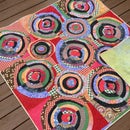Introduction: Screen Printing With Dish Washing Soap
Cheap dish washing soap - the kind that goes in a dishwasher - usually has bleach in it. The thickness and viscosity of the soap makes it perfect for silk screening. Plus, the soap can stay on the fabric for days with no harm to the fabric, and unlike using bleach to remove color dishwashing detergent does not need to be neutralized to stop the bleach from making little holes in your favorite t-shirt.
Step 1: Supplies
- Dish washing detergent containing bleach - read the ingredients
- an old towel to make a soft surface
- pins
- a silk screen
- black or at least very dark fabric
- credit card to use as a squeegee
Step 2: Getting Started
In this project I am using an old boring black cotton tunic top. For the design I made a copy of one of my son's drawings from when he was little - now he's 19.
I make my silkscreens by using an old 3M machine that used to be used to make over-head projector documents. Nowadays it's used a lot in the tattoo industry to transfer designs to bodies - so they are not cheap. It's called a thermofax machine and basically it takes the carbon from a copy made on a copier and burns that carbon onto a mesh screen that is coated with plastic film. The plastic film is burned away where the carbon is present, and lets the ink or paint or in this case, dish washing detergent, pass through the mesh.
So, I make a drawing, or copy one of my son's, put it into the copier and put the copy of the drawing into the thermofax with some expensive mesh film and in less than 5 seconds I have a screen ready to put in a plastic frame and start printing.
Thermofax machines may be bought on ebay or from Welsh Products, but that is not what this 'ible is about - I'm only saying all of the above just in case you want to know. Any silkscreen, made any way that you want to make it, will work. There are lots of folks out there who will make a thermofax screen from your artwork as well. In exchange for money.
Step 3: Printing
I think when you are printing on fabric or your own clothing it looks best to go right off the edge, don't contain the design within the bounds of the fabric. And in the case of printing with a bleach product it looks even better when you overlap - the double dose of bleach gives you variations in color.
Whenever you remove color from black fabric you never know what you will get, sometimes it can be bright orange, sometimes yellow, but seldom is it white. It all depends on what colors were mixed to dye that particular fabric.
Dishwashing soap takes a lot longer to remove color than bleach, it will dry, you can stick it in a drawer and forget about it for a year, as I did a year ago, find it and and stick it in the washing machine and poof! color removed. Best part is the fabric's not damaged - even after prolonged forgetfulness.
So, wait until you like the level of color that has been removed and then be sure to wash it. I don't even add soap - after all you are using dishwashing detergent. This can take anywhere from minutes to hours, probably not a year. Once the dishwashing detergent has dried I doubt it is still working.
Use an old towel under your fabric because you will always get better images when you have a soft surface. Also, pin the fabric taught - it's like having a third hand and hey, we all wish we had a third hand.
Step 4: Adding Color Back
One of the fun things about removing color is to add color back. In this case I mixed up some Procion MX red dye (you may use any dye appropriate for your fabric). The dye will only show up where the color has been removed. Basically it is the only way to print color onto black fabric and have it look good. Yes, it's a lot of steps but hey, you know the old saying.
I like to print this way because it does not change the way the fabric feels. Paint, even fabric paint - changes the feel of the fabric. In fiber parlance we call that the 'hand' of the fabric because we are too cool to explain it the way I just did above.
Step 5: That's It - Happy Printing!
I think the tunic became a bit richer looking when I stuck it in the red dye, there is really no way you can hurt black fabric by adding dye to it. The silk screened designs really pop now, but they would have looked 90% as good with just the dishwashing detergent.
Have fun and ask any questions you want, I always keep up with my 'ibles and if you follow me I will be posting more soon as my friend Jayefuu and I are having a little contest to see who can get the most views by New Years.













